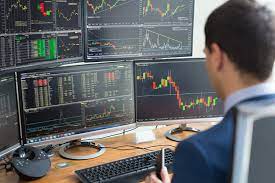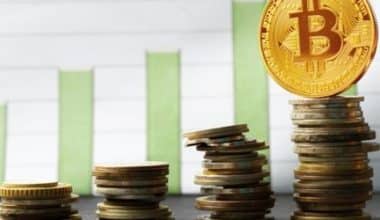One of the most popular trading methods is day trading. Most financial markets, including stocks, forex, commodities, and, of course, cryptocurrency markets, have day traders. Is it, however, a good idea to trade day cryptocurrency? What is the source of income for day traders? Is it a good idea for you to begin day trading? Unfortunately, we do not have a single answer to those questions, but this article will explain what you should know before you begin day trading cryptocurrency.
Day Trading Cryptocurrency
For decades, traders have concentrated their efforts on a few key markets in order to benefit. Cryptocurrencies have been viewed as a developing industry with improved liquidity and trading profit opportunities in recent years. A cryptocurrency is a digital asset that is protected by consensus techniques like proof-of-work or proof-of-stake, and transaction data is kept on a digital ledger. Thousands of cryptocurrencies exist now, providing a wide range of trading options for day traders.
#1. Bitcoin
Bitcoin has become the industry standard in the cryptocurrency realm. Not only has the digital asset risen in popularity, but it has also advanced in terms of technology. Bitcoin is intended to be a decentralized digital currency that can be used anywhere in the world without fear of censorship. Bitcoin has a limited number of 21 million coins that can be mined at any time. With a market capitalization of about $200 billion, it has remained the most valuable cryptocurrency on the market. Bitcoin accounts for over half of all trading activity, with a daily turnover in the billions of dollars. Bitcoin is one of the most popular options for people wishing to day trade cryptocurrency due to its high liquidity.
#2. Alt coins
An altcoin is a cryptocurrency that is not bitcoin. Cryptocurrencies in this category have a wide range of technological differences and applications, ranging from the development of decentralized applications (dApps) to the creation of a world of decentralized finance and beyond. Ethereum, a programmable open-source blockchain, is one of the most well-known altcoins. Many other altcoins exist in the form of ERC-20 tokens, which are based on the Ethereum protocol. EOS and TRON are two of them.
#3. Stablecoins
There is one type of cryptocurrency that has grown in popularity among traders and investors. Stablecoins are cryptocurrencies that have a reasonably consistent price because they are pegged to fiat currency. Tether (USDT) is the most popular stablecoin, with a price tied to the US dollar. Many exchanges avoid dealing in USD for regulatory reasons, but listing coins against USDT allows them to quote against the world’s primary reserve currency without actually dealing in it. Tether is an excellent trading pair for bitcoin and altcoin traders because it allows them to trade within cryptocurrencies without having to offload capital to fiat currency and then back into the market.
What is day trading?
Day trading is a trading method in which positions are entered and exited on the same trading day. This approach is also known as intraday trading because the trading takes place on the same day. The purpose of day traders is to profit from price swings in a financial instrument by employing intraday trading tactics.
The phrase “day trader” comes from the stock market, where trading is only on business days. Day traders, in this perspective, never leave positions open overnight since they want to profit from intraday price changes.
How do day traders make money?
Day traders that are successful will have a thorough comprehension of the market as well as a significant amount of experience. Technical analysis (TA) is commonly used by day traders to generate trade ideas. To choose entry and exit locations for trades, they typically employ volume, price activity, chart patterns, and technical indicators. Day trading, like any other trading method, relies on risk management to be successful.
Day traders may not be concerned with fundamental analysis because fundamental events can take a long time to unfold (FA). Even yet, some day traders use “trading the news” as part of their strategy. This entails locating assets with high trading volume as a result of a recent announcement or piece of news and profiting on the brief increase in trading activity.
Day traders seek to profit from market turbulence. As a result, day trading relies heavily on volume and liquidity. Day traders, after all, rely on excellent liquidity to execute swift trades. This is particularly true when it comes to leaving a job. A day trader’s trading account can be ruined by significant slippage on just one deal. Day traders generally trade extremely liquid market pairs because of this.
One market pair, such as BTC/USDT, is traded by certain day traders. Others will make a watchlist based on technical or fundamental characteristics (or both) and then choose which instrument to trade from it.
Day trading Cryptocurrency strategies
#1. Scalping
Day traders frequently use the tactic of scalping. It entails profiting from minor price movements that occur in short time frames. Liquidity gaps, the bid-ask spread, and other market inefficiencies are examples.
Scalpers may frequently trade on margin or with futures contracts in order to increase their profits through leverage. Larger position sizes make more sense because percentage price targets are typically smaller. In fact, most day trading tactics fall into this category.
Trading using leverage, on the other hand, does not negate risk management concepts. A successful scalper will understand margin requirements and use suitable position sizing criteria. Check out How to Calculate Position Size in Trading if you want to learn about a basic formula for sizing positions.
Scalpers can establish their entry and exit locations for individual trades using tactics including order book analysis, volume heatmaps, and a variety of technical indicators. Scalping, on the other hand, is often more ideal for skilled traders due to the quick transaction execution and high risk. Furthermore, because of the widespread use of leverage, a few unsuccessful deals can quickly deplete a trading account.
#2. Range trading
Range trading is a straightforward approach that relies largely on candlestick chart analysis and the examination of support and resistance levels. In addition, range traders, as the name implies, search the market structure for price ranges and formulate trading ideas based on those ranges. If the price is ranging between two levels of support and resistance, a range trader might buy the support and sell the barrier. They might, on the other hand, sell short at the resistance level and exit at the support level.
The theory behind range trading is that the range’s edges will act as support and resistance until the range is broken. This means that the lower end of the range will most likely push the price higher, while the upper end will most likely push the price lower.
The more times a price touches a support or resistance level, the more probable the level will be broken. As a result, range traders will always be for the possibility of the market breaking out of the range. Typically, this entails placing a stop-loss order at a level where the range breakout has been confirmed.
Check out The Basics of Support and Resistance Explained for more information on this subject.
Range trading is an easy-to-understand method that is suitable for newcomers. It necessitates a thorough knowledge of candlestick charts, support and resistance levels, and momentum indicators like the RSI and MACD.
#3. High-frequency trading (HFT)
Quantitative traders utilize high-frequency trading as a type of algorithmic trading approach (“quant” traders). It entails creating trading bots and algorithms that can quickly enter and exit several positions in a short period of time. What is the length of these time frames? Consider milliseconds. For a high-frequency trading firm, a few milliseconds of advantage can mean a huge advantage over competitors.
Highly sophisticated tactics could be implemented using HFT algorithms. While high-frequency trading may appear to be a simple day trading method, it is far more sophisticated. Backtesting, monitoring and adjusting algorithms to adapt to ever-changing market conditions are all part of high-frequency trading. So, if you think you can just sit back and let a trading bot handle everything for you, you’re definitely mistaken.
Another factor to consider is that high-frequency trading is a very field. As a result, the general population has a difficult time finding high-quality information. What is the reason for this? It’s actually fairly straightforward. Those tactics would no longer function if successful trading businesses and hedge funds began sharing their high-frequency trading strategies with individual investors.
In addition, when it comes to trading bots, there is one more thing to consider. Why not employ a profitable trading bot instead of selling it if someone has created one? This is why, if you’re considering buying a high-frequency trading bot, you should proceed with caution.
#4. Technical analysis
The study of financial data such as historical price and volume data points to identify statistical trends in the markets is technical analysis (TA). TA teaches traders how to use science to locate profitable trading chances.
As long as there are historical trading data, technical analysts can apply their strategy to any market or security. In the crypto world, TA can be to assess how previous performance can predict future gains or losses.
The applicability of TA in the crypto markets is a contentious issue among traders. Many people believe that crypto is incompatible with technical analysis due to the lack of global regulations and a large number of exchanges. Others feel that metrics such as the relative strength index (RSI) are useful. The RSI indicator assesses the link between a cryptocurrency’s price and its actual demand. The RSI can help traders map entry and exit points based on the momentum by determining whether an asset or security is overbought or oversold.
The Money Flow Index is another major oscillator used by technical analysts in crypto (MFI). The MFI can be combined with the RSI to determine whether BTC is going towards a bullish or bearish divergence.
#5. Bot trading
A trading bot is a software application that allows investors to purchase and sell financial instruments at a predetermined time or when certain circumstances are in order to optimize earnings. Crypto trading bots are to boost profits while lowering losses and risks.
Day trading cryptocurrency bots can speed up the process of analyzing price changes, exchange fees, and the potential to benefit from deals in the near term. Bot trading software has been a feature of stock exchange brokerages for decades. Traders that are familiar with software development and APIs should consider using this knowledge to their advantage as day traders.
How to Get Started with Day Trading Cryptocurrency
So you’ve decided to give day trading cryptocurrencies a shot. What should you do first? You might want to read A Complete Guide to day trading cryptocurrency for Beginners, which explains all you need to know about trading and includes some advice for retail investors. If you’re familiar with the fundamentals, you can practice trading on the Binance Futures test net. You may test your trading method without risking any actual money this way.
But which online trading platform is the best for day trading cryptocurrency? We can’t make your decision for you, but the Binance ecosystem includes hundreds of market pairs, margin trading, quarterly and perpetual futures, leveraged tokens, real-time market data, and more. Simply go to Binance and convert your fiat dollars to cryptocurrency to get started.
Should I Start Day Trading for a Living?
Day trading cryptocurrency can be a lucrative technique, but there are a few things to keep in mind before starting. Day trading can be difficult and demanding because it necessitates quick decision-making and execution. This day trading is dangerous and necessitates a thorough understanding of the market. It will, of course, necessitate long durations of staring at displays.
Are you capable of carrying all of this weight while potentially losing money? You’ll need to think about if day trading is good for your investment goals and personality.
Check out A Beginner’s Guide to Cryptocurrency Trading Strategies if you’re not sure if day trading is the appropriate technique for you. In that post, we go through a variety of tactics that can be beneficial to active traders, such as swing trading. Learning about these methods will help you make better decisions when it comes to determining your trading style.
Which Cryptocurrency is Best for Day Trading?
Any blanket judgments of “best” and “worst” regarding cryptocurrencies are likely to be rendered obsolete within a few months due to the very volatile and highly dynamic nature of crypto assets. Find out whether a certain cryptocurrency has high liquidity (plenty of fiat currency linked with it, which is frequently represented as market cap=-‘) and high trading volume. This is a straightforward method for determining whether a given cryptocurrency is a viable option for day trading (lots of people trading it). In a perfect world, both of these figures ought to be in the neighborhood of several hundred million United States Dollars or more.
What Are the Downsides of Day Trading Crypto?
Cryptocurrency has been responsible for the creation of many fortunes, but investors should never forget that many, many times that amount has also been lost. Price declines out of nowhere are the other side of the exceptional price increases of several hundred percent. It is imperative that you keep in mind the fact that the extremely high volatility of cryptocurrency prices is a double-edged sword. It’s not a question of if you’ll lose money, but when. The effectiveness of your plan will determine whether or not that loss is catastrophic or merely inconvenient.
The cryptocurrency market is fraught with a number of one-of-a-kind security hazards, in addition to the price volatility that accompanies it, which cannot be found in conventional financial markets. You should be aware of the hazards associated with security breaches that can occur at centralized cryptocurrency exchanges.
Last but not least, trading fees can amount to a significant sum of money, which is especially the case for trading techniques that include a very large volume of transactions. Before making an investment in a trading platform, it is essential to have a thorough understanding of the fees associated with actually using the platform.
Should I Buy Cryptocurrency First Thing in the Morning or Late at Night?
When there are fewer customers in the market, prices drop. Even though cryptocurrency trading is possible around the clock, most action takes place when traditional businesses are open for business. The market is quieter in the early morning, late at night, and on the weekends. In most cases, the price of cryptocurrencies is lowest on Monday and gradually increases throughout the week.
Pros and Cons of Day Trading Cryptocurrency
Any cryptocurrency investment is a high-risk, high-reward proposition. Cryptocurrencies are a new type of digital asset, and investors should always keep in mind that their crypto investments could vanish.
Traders should set aside time to become familiar with the impending laws and regulations governing the taxation of crypto earnings. For example, crypto is not exempt from short-term capital gains tax. The sale of any cryptocurrency for less than a year is a marginal source of income for day traders. When reporting earnings online or with your accountant, make sure to include your cryptocurrency gains.
#1. Pros
- Anyone with a crypto exchange account is free to trade. There are no further hurdles to entry for retail investors or day traders to access, research, and participate in the crypto markets aside from authenticating their identification and paying their exchange account. Those who wish to acquire bitcoin but cannot afford to pay $60k or more can buy and sell a fraction of any cryptocurrency.
- The crypto markets are open all year round, 24 hours a day, 7 days a week. Because the crypto markets are open 24 hours a day, traders can buy and sell without restrictions. Market hours for the New York Stock Exchange or the Nasdaq are from 9:30 a.m. to 4 p.m. ET. The convenience of being able to trade whenever you choose is one of the benefits of having access to the market 24 hours a day, 7 days a week (rather than suiting the market).
- Cryptocurrencies and the blockchain technology that underpins them are decentralized and keep users anonymous while also allowing them to conduct payments without the involvement of a middleman. The lack of government taxes and fees makes dealing with crypto incredibly cheap for day traders on a centralized exchange.
#2. Cons
- Because it’s so simple to start trading cryptocurrency, rookie or inexperienced traders might suffer catastrophic losses just as readily as they can profit.
- The market is a two-edged sword since it is open 24 hours a day, seven days a week. Because bitcoin is always open, there are fewer patterns in the day when traders may make predictable (and profitable) deals. Crypto-day traders may find themselves riveted to the charts for longer periods of time than they would in traditional markets, seeking the best time to execute a trade. This makes it more difficult to see patterns, and a brief day trading session can quickly turn into a night trading session.
- While US government watchdogs such as FinCEN are gradually tightening the know-your-client and anti-money laundering regulations for domestic crypto exchanges, the market is still mostly uncontrolled. Because there is no government control, exchanges, institutions, and traders who are hacked or duped have no protection. This means that if an exchange goes down, users are unlikely to get their money back unless they have a private insurance fund.
- You could be a victim of pump-and-dump schemes or wash sales if you trade cryptocurrencies. This happens when a group of people works together to artificially inflate the price of a cryptocurrency in order to lure in naïve traders. After profiting, the traders sell the cryptocurrency, causing the price to plummet.
How Much Money Do You Need to Day Trade Crypto?
I want to start investing in cryptocurrency, but I’m not sure how much money I need to get started. Theoretically, all that is required to make an investment in bitcoin is a few bucks. For example, the majority of cryptocurrency exchanges require a minimum trade amount of at least $5 or $10. There is a possibility that some cryptocurrency trading apps have a minimum that is even lower.
Which Crypto is Best to Day Trade?
Dogecoin is now the most suitable cryptocurrency for day trading because of its high volatility, liquidity, volume, and news coverage. Day trading is an activity that has the potential to yield very high profits. Having said that, you will need to formulate a plan and adhere to it. To begin cryptocurrency day trading, you need not, contrary to popular belief, need a set sum of money.
Is Day Trading Crypto a Good Job?
Although day trading can be a profitable strategy for investors who have the time and are willing to put in the effort to develop an effective trading strategy, the easiest, most efficient, and most profitable way to day trade for the majority of people is to automate your strategy by making use of crypto trading bots. Day trading can be profitable for investors who have the time and are willing to develop an effective trading strategy.
What Percentage of Crypto Day Traders Make Money?
In any given year, approximately 19% of the heavy traders who trade more than $20,000 per day made positive anomalous returns, which means they outperformed the market after costs were deducted. That works out to 1 in 5. Only four thousand people, or less than one percent of the total population of day traders, were able to consistently make a profit after fees were deducted.
Conclusion
Day trading is a popular trading strategy in both the stock and cryptocurrency markets. Intraday trading methods are used by day traders to profit from market volatility, and they normally do not hold positions for more than one day.
Day traders analyze trade setups using technical analysis, chart patterns, and technical indicators. Scalping, range trading, and high-frequency trading are some of the most popular day trading tactics.
FAQs
How much can you make day trading crypto?
High-volatility microcins can gain multiples in 1 day, providing exponential returns to lucky investors. High volatility also means those coins can move in the wrong direction just as quickly. As the potential reward increases, so does risk.
Which crypto coins are the best for day trading?
Day traders look for volatility. Volatility is most prevalent in microcins, or coins with small market caps compared to other cryptos. Right now, any coin with a market cap lower than $1 billion is considered small-cap. Some small-cap coins with good trading volume include SiaCoin (SIA), Basic Attention Token (BAT), and Fusion (FSN).






